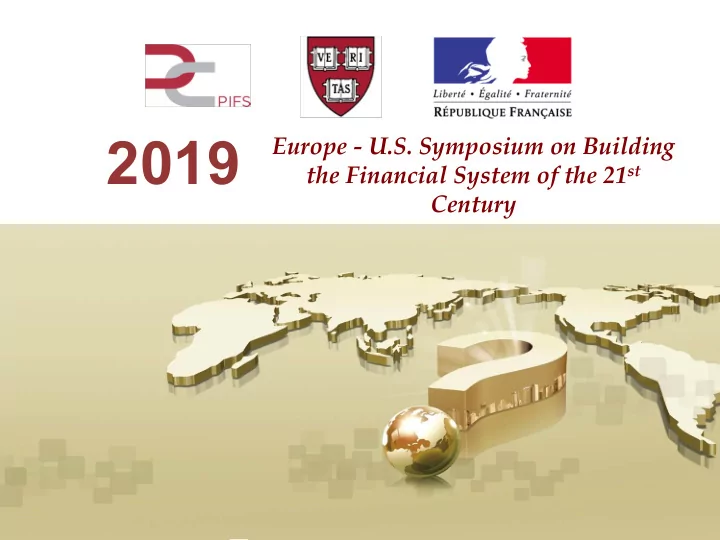

Europe - U.S. Symposium on Building 2019 the Financial System of the 21 st Century
Threats to Cross-Border Banking: Resolution and Brexit • Cross-border resolution – global dimensions – Ringfencing has become the global norm • Subsidiarization, internal TLAC • Is SPOE effectively dead? – Lack of legal clarity - definitions, functions, regulation of branches vs. subs – Coordination in case of actual resolution • Trust and ringfencing – “trust” and coordination are easier when the cash is in place (TLAC, MREL, etc) – Lingering questions: • Is fragmentation reasonable price to pay to protect taxpayers? • Fed’s toolbox to stop contagion limited by Dodd-Frank • Is banking more or less fragile in this new world?
Threats to Cross-Border Banking: Resolution and Brexit • Cross-border resolution – Europe – Even within EU, cross-border resolution is challenging – Italy examples: bail-out rather than bail-in – Gaps persist among ESRB, EC, and national authorities • EU resolution directive superimposed on varied national bankruptcy laws • Actual bank failures follow political, not just legal, logic – SRF still not fully funded – Basic problem: EU is trying to solve political problems through regulation, but outcomes ultimately depend on social impact
Threats to Cross-Border Banking: Resolution and Brexit • Brexit and “enhanced equivalence” – Is this a promise or a threat? • UK may face higher information and legal requirements, extraterritorial supervision • Implications for US? – Opening the black box of equivalence • Reducing UK uncertainty of future – reciprocity? procedural transparency? • Is there a multilateral solution to the web of bilateral agreements? – Equivalence should be outcomes-based, non-politicized • Should not require submission to extraterritorial supervision – Goals of actors differ • EU: accommodating Brexit is secondary to CMU, SRF; seeking competitive advantage • UK: bank branches in EU limited, so main concern is markets and CCPs
Threats to Cross-Border Banking: Resolution and Brexit • Fragmentation as the new normal in Europe – Limited European financial market so far, despite CMU dreams • Fragmentation results from regulation, supervisory practices, politics – MiFID II effects – liquidity pools, localization of CCPs, etc – Effects of fragmentation • Liquidity down, costs up • May be price of being global for banks, but damaging to asset managers • Does not improve resolvability – Politics of fragmentation • Are European countries looking again to national champions? • Is Brexit just one example of populist-driven fragmentation?
The Evolution of the Asset Management Industry • Changing face of asset management – Key question for regulators and industry: how well are end- investors being served? – Competition and tech • Changing trading and allocation strategies • Driving down costs for investors – Changing balance of active and index funds • Debate on impact of index investing on liquidity, price determination • Retail distributors shifting from selling funds to selling portfolio allocation
The Evolution of the Asset Management Industry • EU asset management – Market liquidity and efficiency lag US – EU regulators still see asset managers as big, bank-like SIFIs • But end-users actually own shares, not funds, & mutual funds not leveraged • Lingering suspicions of foreign asset managers, preference for domestic • Is ECB the right regulator? – Structural challenges • Lack of private pension funds retards both growth of asset management sector and feasibility of CMU • Lack of culture/tradition of risk capital in much of Europe – Effects on allocation of capital, economic growth
The Evolution of the Asset Management Industry • Composition of indexes – Bespoke “indexes” subvert the whole point • Not really indexes • Grading on their own curve – Is there a role for government? • Standard setting, transparency, “taxonomies” • May be a slippery slope! – Potential benefits of competition among indexes and index funds • Benchmarks and the EU – Desire to protect investors (lessons of LIBOR) – Increasingly assertive regulation • What are pros and cons? • Extraterritoriality: will EU regulate the entire extended family of IBORs? How?
The Evolution of the Asset Management Industry • ESG and asset management – Europe is asking asset management to solve societal issues • Comprehensive strategy or just shifting responsibility? • Should bear in mind that regulation of asset management means regulation of household assets – ESMA is building ESG agenda • Taxonomy of green companies • Will it go beyond mandated disclosure (e.g., risk-weighting of bonds)? • How to integrate with benchmarking rules? – How will Europe’s ESG agenda affect the world • Global leader? • Effects on US firms?
The Evolution of the Asset Management Industry • US approach is still private, voluntary – Private standard-setting bodies • E.g. Sustainability Accounting Standards Board – Market-driven • Disclosure remains voluntary (but will this change under President Warren?) – Very different political status of sustainability from EU • ESG and risk – Increasing sense that ESG aligns with long-term profitability – How to measure ESG commitment and impact? • Need better, more standardized data – who will provide? • What are the necessary tools and models?
UPCOMING EVENTS 2019 China - U.S. Symposium June 5 – 7, Washington, D. C. Japan - U.S. Symposium October 4 – 6, Odawara, Japan To receive an invitation to other PIFS Symposia, or to recommend your colleagues for participation, please contact: Whitney Vasey wvasey@pifsinternational.org | 857-242-6072 www.pifsinternational.org
Recommend
More recommend